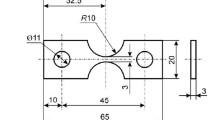Conclusions
-
1.
The effective fracture toughness of the investigated alkali halide single crystals increases with an increase in pressure.
-
2.
This effect is described well by Eq. (11), which was derived on the basis of the assumption of the addition to the effective surface energy caused by the action of high hydrostatic pressure on the elastic tip of the crack and of plastic relaxation of the stresses as the basic controlling factors.
-
3.
The model obtained predicts the same slope of the K *Ic (P) relationship with small values of P for all brittle and semibrittle crystalline bodies in the geometry of the double cantilever beam specimen. In intermediate cases investigations of the dislocation structure are necessary for description of this relationship.
-
4.
For LiF single crystals a transition from bittle cleavage to semibrittle failure, which is controlled by the appearance and elongation of the slip lines (dislocation accumulations) originated by the crack, was observed. The dislocation structure in cleavage of NaCl and KCl makes it possible to include these crystals among initially semibrittle bodies.
-
5.
One of the main reasons for the change in mechanical behavior of crystals and the increase in dislocation activity under high hydrostatic pressure conditions is the increase in the rate of liberation of elastic energy for accomplishment of the work for formation of the elastic tip of the moving crack.
Similar content being viewed by others
Literature Cited
V. A. Strel'tsov, G. Ya. Akimov, and I. Yu. Prokhorov, “The fracture of crystalline solids under conditons of hydrostatic pressure,” Fiz. Tehk. Vysok. Davlenii, No. 12, 60–87 (1983).
G. Ya. Akimov and I. Yu. Prokhorov, “Fracture of hydrostatically compressed NaCl single crystals,” Phys. Status Solidi (a),79, No. 2, 423–431 (1983).
Calculations and Tests for Strength. Methods of Mechanical Tests of Metals. Determination of the Characteristics of Fracture Toughness (Crack Resistance) in the Crack Arrest Stage. MR 71-2 [in Russian], Standartov, Moscow (1982).
L. I. Sedov, The Mechanics of a Continuum (in two volumes) [in Russian], 4th ed., Vol. 2, Nauka, Moscow (1984).
I. Yu. Prokhorov, “Hydrostatic treatment of alkaline halide single crystals with cracks,” in: Hydrostatic Treatment of Materials: Summaries of Papers for the Fourth All-Union Conference [in Russian], Donetsk. Fiz.-Tekh. Inst., Akad. Nauk UkrSSR, Donetsk (1985).
G. S. Pisarenko, V. P. Naumenko, O. V. Mitchenko, and G. S. Volkov, “Experimental determination of the value of KI in compression of a plate along the line of a crack,” Probl. Prochn., No. 11, 3–9 (1984).
R. W. Honeycomb, Plastic Deformation of Metals, St. Martin (1968).
H. Koizumi and T. Suzuki, “The influence of yield stress on fracture,” Phys. Status Solidi (a),68, No. 2, 579–588 (1981).
C. N. Ahlquist, “The influence of yield strength on fracture of semibrittle ceramic crystals,” Acta Met.,22, No. 9, 1133–1137 (1974).
Additional information
Donetsk Physicotechnical Institute, Academy of Sciences of the Ukrainian SSR. Translated from Problemy Prochnosti, No. 7, pp. 23–28, July, 1987.
Rights and permissions
About this article
Cite this article
Akimov, G.Y., Prokhorov, I.Y. Crack resistance of hydrostatically compressed alkaline halide single crystals. Strength Mater 19, 896–901 (1987). https://doi.org/10.1007/BF01523525
Received:
Issue Date:
DOI: https://doi.org/10.1007/BF01523525




